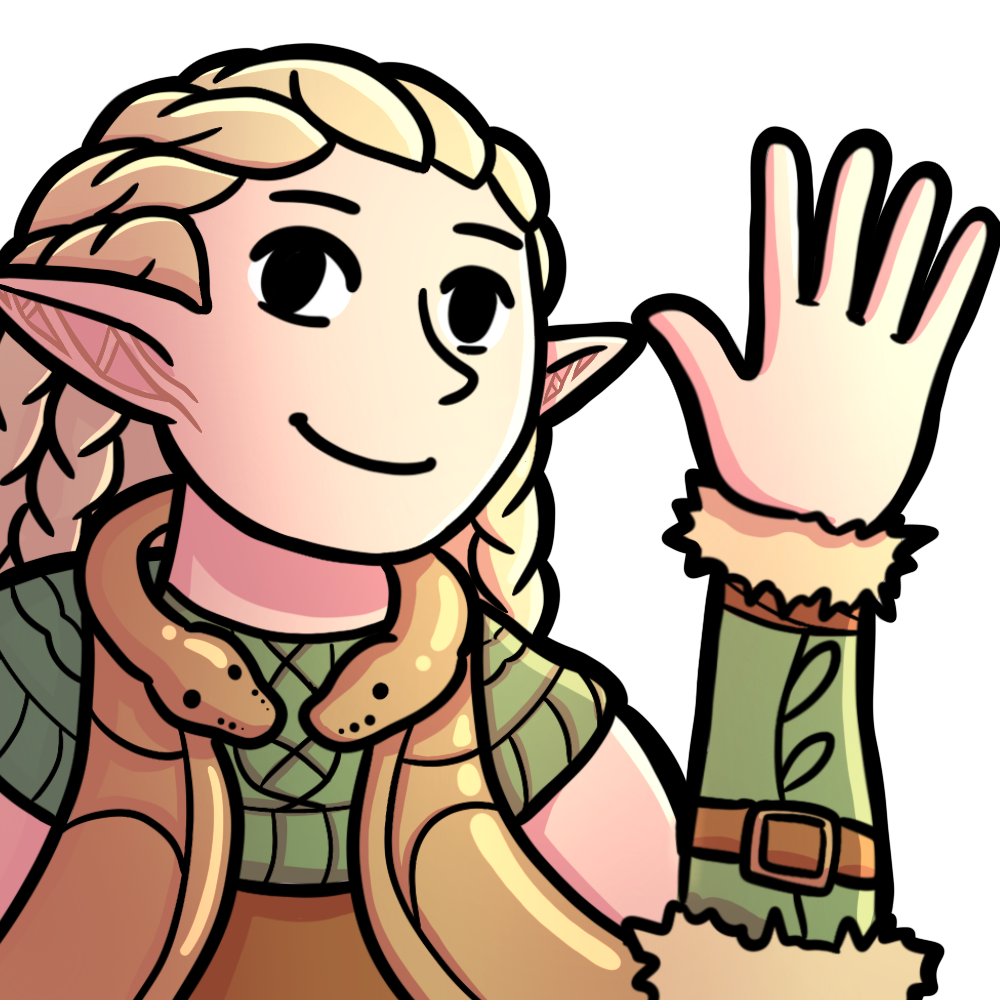Standard Slogurk Pt. 2: Inti Broke It
12/29/2023
This is a sequel to a previous article about Slogurk in Standard. I would highly recommend you read that one first - specifically, the part that talks about the core Slogurk loop. I won't be going into as much detail about that part of the deck in this article.
I've always been a fan of
Slogurk, the Overslime as a card. In my previous article, I talked about the Sultai Slogurk deck I had been working on before LCI - I didn't think it was busted per se, but it was very much my pet deck. While it had some issues, it contained a very powerful lategame engine that could go over the top of any other deck, and thus was very worth paying attention to going forward. In that article, I wanted to lay out what I had found so far, to perhaps lay the foundations for future innovation.Now, I come to you with a different claim: I broke it.
Well, that's probably hyperbole. I don't think Slogurk is truly broken yet - it still has a few vulnerabilities, and could suffer if it were ever targeted by hate. But whereas in the past I thought it was a simply decent deck that I favored as my pet deck, I now think it is the deck I would unironically strongly recommend as the best deck in Standard.
Part 1: Inti
So what changed? Last time we left off, I talked about how it didn't seem like there was much in LCI that improved Slogurk as a deck. I pointed at a few small upgrades, but didn't find anything that would truly take the deck to the next level. However, I overlooked a huge addition in an unexpected color: Inti, Seneschal of the Sun.
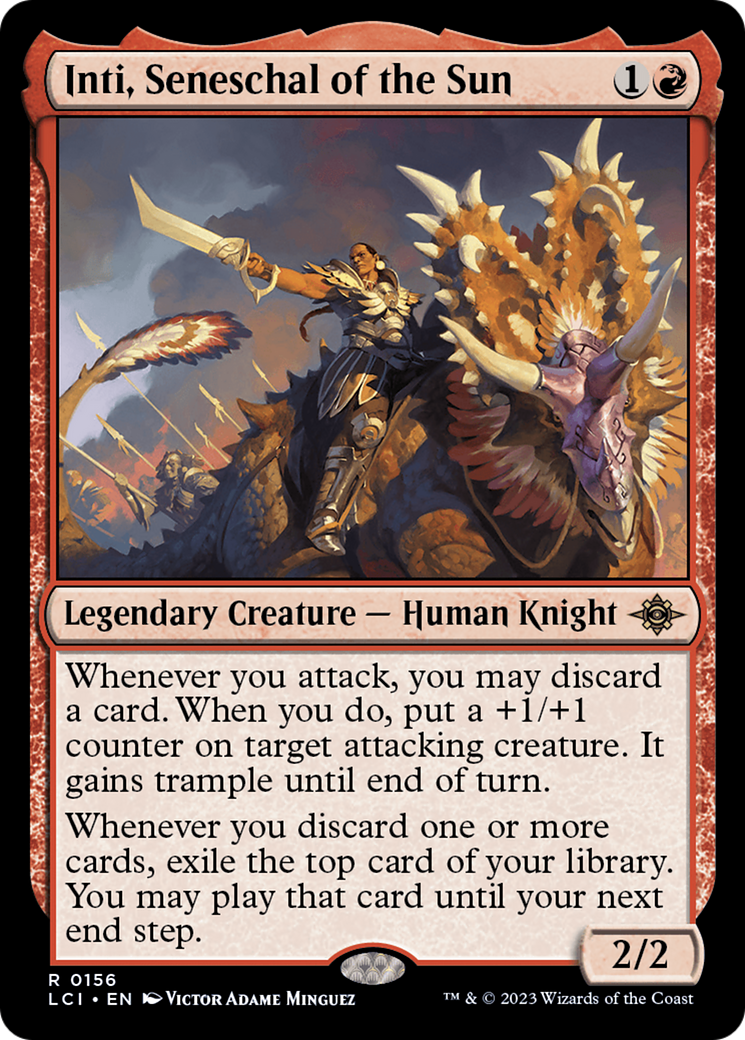
Inti, Seneschal of the Sun
The reason why Inti is such a huge addition to the deck is simple: it provides another engine to pay off channeling lands. Every single time you channel a land, Inti triggers and impulse draws a card. And the timing even works greatly in your favor - channeling on your opponent's turn will give you impulse draws you can play on your turn ("until your next end step").
On top of all of that, Inti is just another good legend we can play. One of the problems with Slogurk in the past has been that you want to play a bunch of legends to reduce channel costs, but there weren't very many good value legends.
Now, with Inti, we have 8 engine cards. The previous iteration of Slogurk was really good when you set it up, but if you didn't find Slogurk the deck could struggle to do anything meaningful. Inti helps solve that problem, and lets us lean even more into being an engine deck.
Part 2: Relic of Legends
With 8 cards now that provide a ton of card advantage, it would be nice to have more mana to use that card advantage. Enter Relic of Legends.
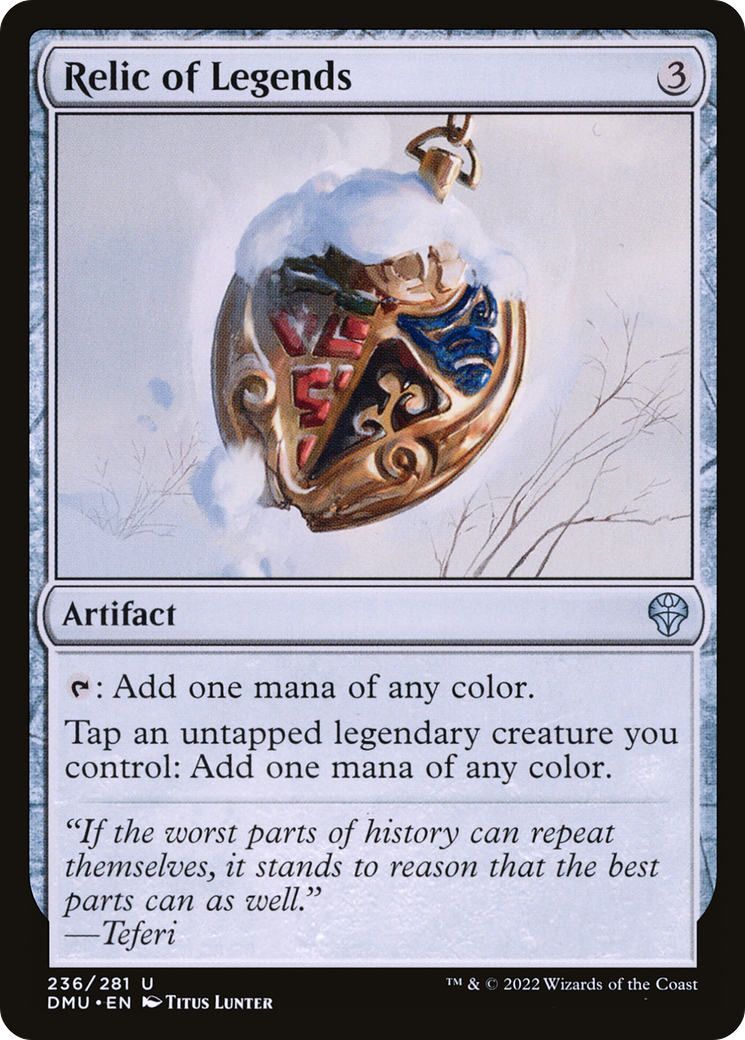
Relic of Legends
It's entirely possible the deck should've already been playing Relic. Slogurk itself is a pretty mana-hungry engine after all, and Relic makes a lot of mana if you have the legends. However, without Inti, I don't think the deck actually had quite enough card advantage engines to justify running more mana sources when it was already up to 29 lands.
Now, though, we can go deeper. Inti serves both as a cheap legend that we can tap with Relic, and more importantly as a card advantage engine that can use the mana from Relic. Plus, Inti helps alleviate some of the problems of running Relic - if we don't need the mana, we can discard it (and especially extra copies past the first) to Inti's attack trigger.
How Much Mana?
One of the biggest bottlenecks with this deck is the ability to play Inti or Slogurk, and hold up a channel land as well - if you're able to do that, then you can guarantee that you get at least one card off of the Inti or Slogurk, even if your opponent removes it.
If you only have lands in play, then you need to get to 5 lands before you can do this with Inti, and 6 lands with Slogurk. Extra legends reduce this number - if you play legends on turns 2 and 3, then turn 4 you can play Slogurk and use your one remaining mana to hold up a channel land.
Relic of Legends turbocharges this - suddenly all your legends are counting double, as they both reduce channel cost by 1 and also tap for mana, including the turn you play them. In fact, on an empty board, you can curve Relic of Legends on turn 3 into Slogurk on turn 4, and still have a channel land up!
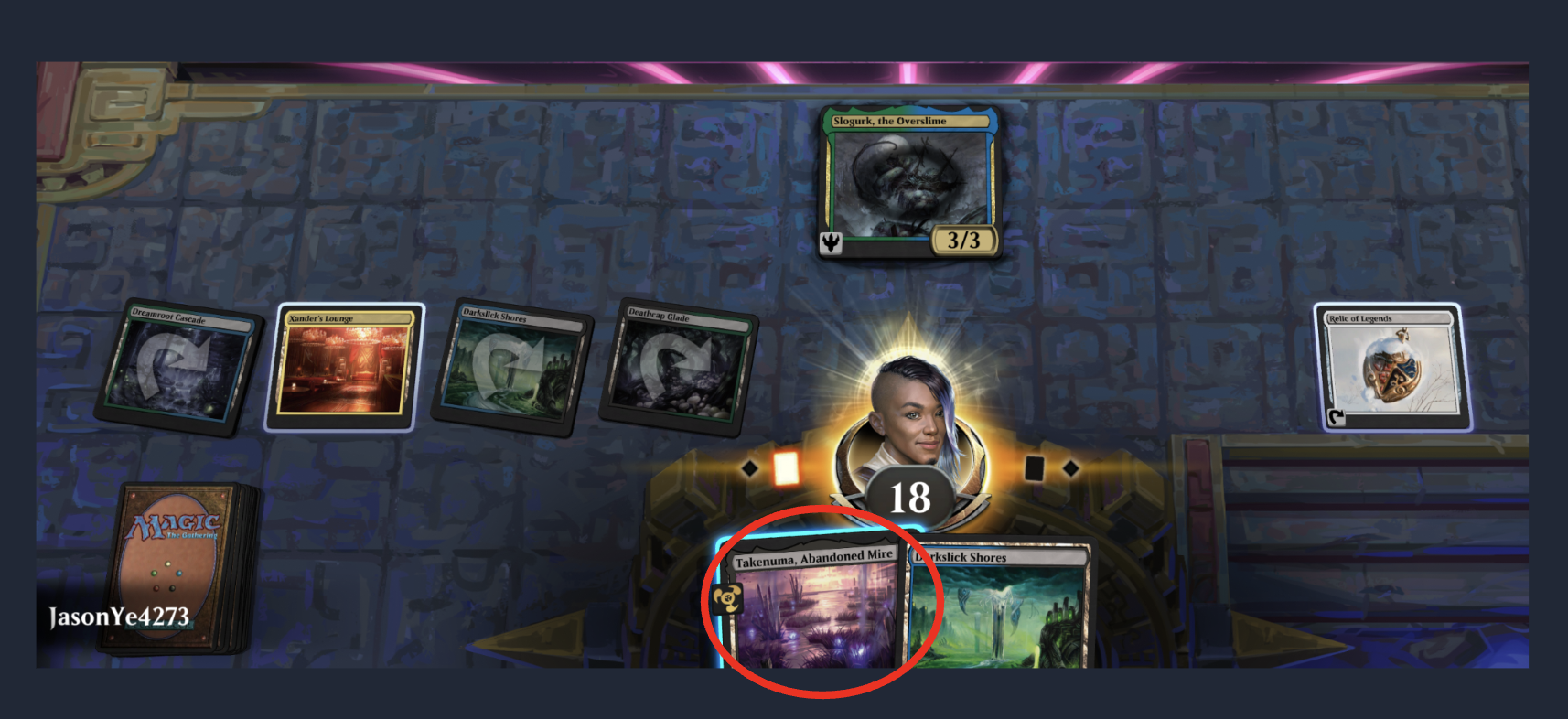
an example of turn 4 Slogurk with a channel land up
Part 3: Rona, Herald of Invasion
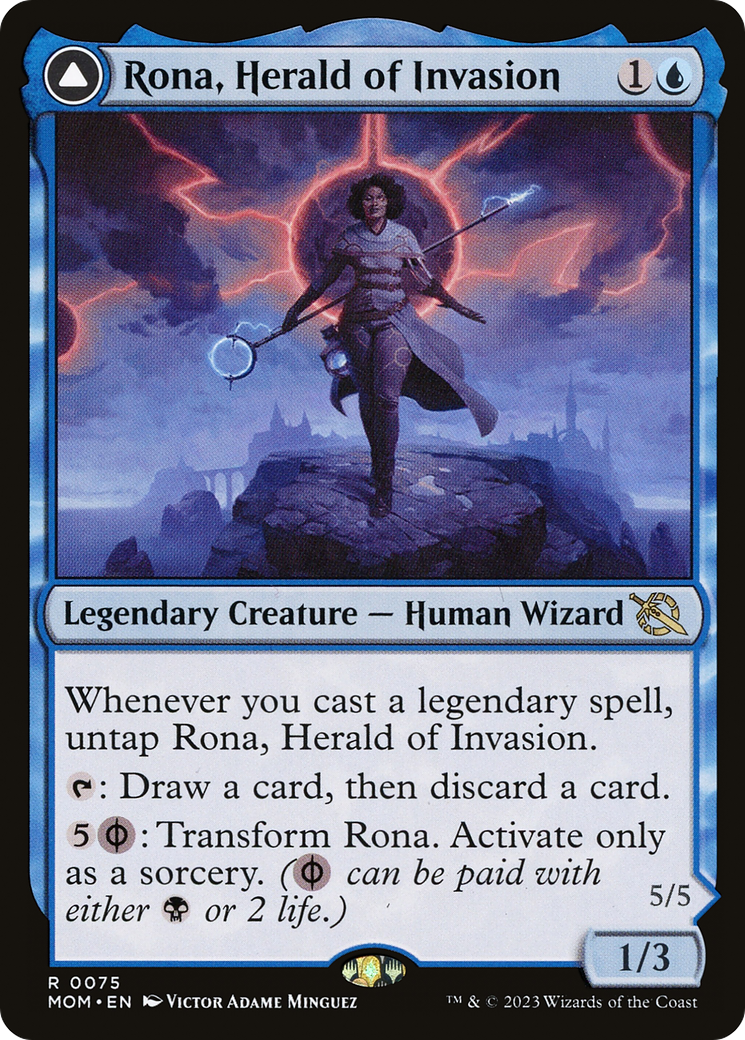
Rona, Herald of Invasion. Backside not shown because it is fairly irrelevant
In the past, I had once cut Rona from this deck. To be fair, it was an old version, and a past meta when UB midrange with
Faerie Mastermind was the deck to beat. My reasoning was that Rona was a good card for filtering, digging to Slogurk, and filling the graveyard; but it was just a bit too risky against Mastermind and just didn't quite do enough.Now, though, with Inti and Relic, Rona becomes a lot more potent.
The repeated looting lets you trigger Inti extra times - with both Inti and Rona out, you get to impulse draw an extra card both once a turn AND once whenever you cast a legend.
And on the flip side, Rona's untap also works with Relic to make even more mana - each legend cast now produces yet another mana when you cast it, as you can first tap Rona to Relic for mana, and then untap it from casting the legend.
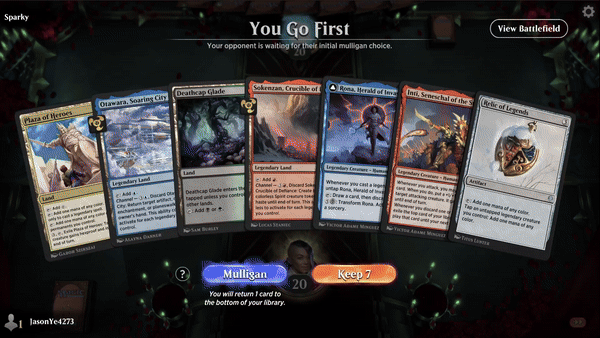
one of the deck's nut draws - Rona on turn 2 into Relic+Inti on turn 3, allowing you to immediately channel a land or loot with Rona on your opponent's turn to trigger Inti
Part 4: The Deck
In my last article, I talked about the core of the deck being Slogurk and
channel lands. Now, we've added Inti, Relic, and Rona to that, as parts of the core engine. So what else do we need?Titania, Voice of Gaea

Titania, Voice of Gaea
After playing with and tuning various versions of Slogurk for quite a while, I've settled on the conclusion that Titania is actually a very important part of the deck. The reason is because it's just yet another form of inevitability, in a dimension that the deck doesn't otherwise cover.
Inti and Slogurk provide card advantage inevitability; Rona and Relic provide mana advantage inevitability; Otawara and Takenuma invalidate removal; Otawara and Sokenzan invalidate threats. The only thing left to worry about is your life total - not every deck plays burn, but fliers are scary as well, and being able to cushion your life total really helps with really turning the corner and sealing that inevitability.
So, I would never want to register fewer than 2 copies of Titania. It's not a card you always need access to, and you don't usually want to draw multiple copies, but it does so much more than any other card to stabilize you.
Cheap Legends
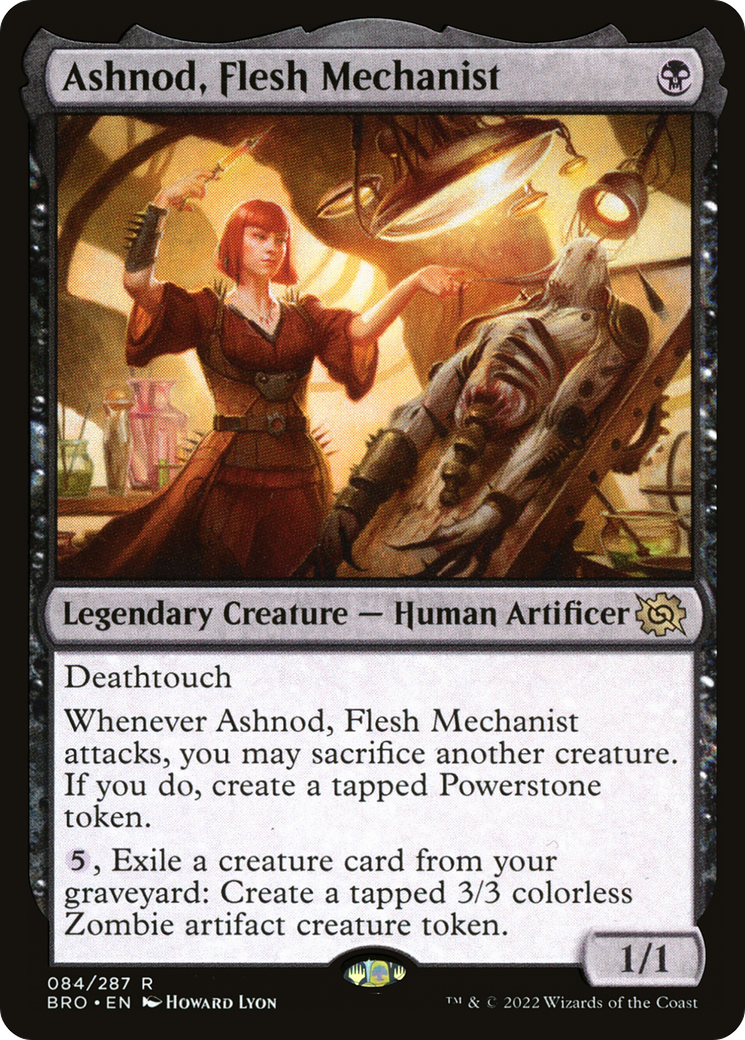
Ashnod, Flesh Mechanist
Before Relic, you could often play a 1 mana legend as a "mana dork" because of how it reduced channel costs - but now with Relic it's even better than that.
With Relic out, 1 mana legends are quite literally free, as they immediately tap for mana. If you throw Rona into the mix, you're suddenly +1 mana, as you get a Rona untap. And of course this is even before counting channel cost reduction.
Interaction
Before, in the sultai version of the deck, I was playing the good dimir midrange interaction -
Cut Down, Go for the Throat, and Make Disappear.This new version with Inti still wants interaction - it helps us get through the early game, while also converting our card advantage late. But as Inti and Relic make the deck leaner and faster, we don't need to lean on having interaction quite as much. Plus, there's a clear cut here - countermagic is pretty bad with Inti.
So, we still play the good black removal, but Make Disappear has to go.
My current decklist
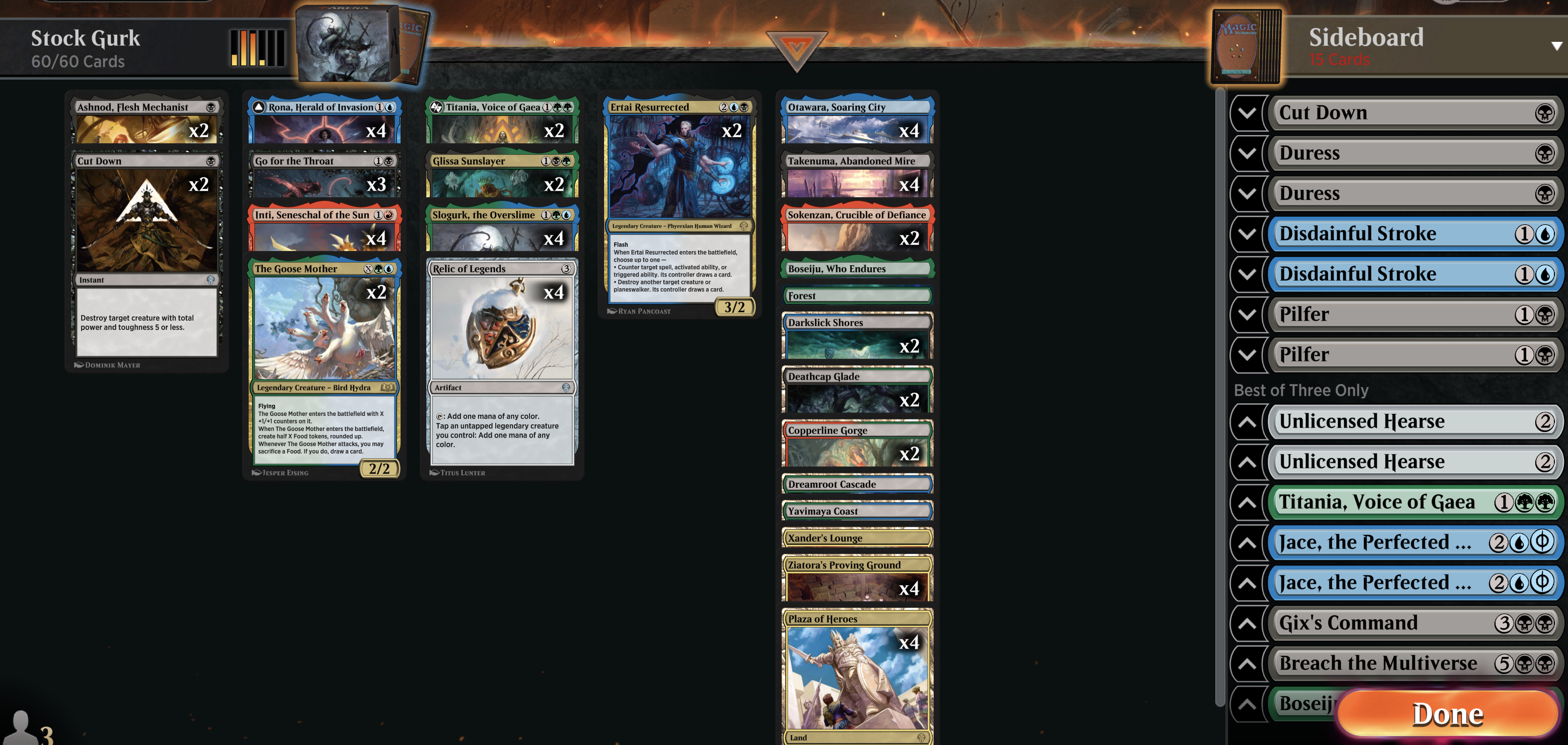
what I consider my current stock slogurk list
In addition to the cards mentioned above already,
Ertai Resurrected is a key piece of flexible interaction that can notably be recurred with Otawara and Takenuma; Glissa Sunslayer is just a good legend threat to help bridge; and The Goose Mother is honestly a flex slot cheap legend that could be mostly anything but is specifically Goose Mother just because it can block fliers.As you can see, slots are quite tight here. I think this maindeck is actually quite tuned, and I would be hard pressed to change the numbers on anything except the flex slots with two Goose Mothers. I could see maybe playing a third copy of any of: Ashnod, Cut Down, Glissa, or Titania. But I wouldn't change the numbers on any of the 4-ofs.
The manabase is fairly thought-out. 4 Otawara, Takenuma, and Plaza are mandatory; 2 Sokenzan and 1 Boseiju are also good numbers. Sources work out for everything except casting Titania on turn 3 (though casting it on turn 4 is very doable). You could convince me there's a bit more optimization you could do on moving around which colors are on which duals/triomes, and you could maybe convince me to play
Argoth, Sanctum of Nature for Titania, but everything else feels pretty locked to me.Part 5: Matchups and Sideboarding
The sideboard is currently not particularly tuned: some of it is good, but there are a few slots still to be figured out (see:
Unlicensed Hearse). I also have not done as much focus testing as I'd like with this deck, but I can still give my thoughts from having played quite a lot on ladder.Generic aggressive creature decks
This includes things like mono-red, mono-white or boros humans, boros convoke, and gruul dinos. This does not include soldiers, notably - that deck is a bit unique.
In general, I think Slogurk is massively favored (70/30 or better) against these kinds of decks. Maybe less so for mono-red specifically (maybe 60/40?), but Titania and a pile of Otawaras is generally pretty hard for aggressive creature decks to beat.
In (3): 1 Titania, 1 Cut Down, 1 Gix's Command
Out (3): it depends a lot on the matchup; often looking at trimming Glissa and/or Goose Mother. Can also trim Rona/Inti if they have actual removal (mono-red).
Soldiers
This can definitely be a scarier matchup than other aggro decks, as Soldiers can grind better and also has more fliers and countermagic. Still, I think it's a slightly favorable matchup (something like 55/45?), but I'd have to do more testing to be sure.
The most important things in the matchup are making sure you can resolve your important spells and dealing with
Harbin, Vanguard Aviator.In (6): 1 Cut Down, 2 Pilfer, 1 Titania, 1 Gix's Command, 1 Boseiju
Out (6): 2 Ashnod, 1 Go for the Throat, 1 Forest, and 2 other cards I'm not sure about (maybe Rona or Ertai?)
Domain
This is one of the weirder matchups, and very hard to play on a technical level. But at the same time, I think it is extremely favorable (probably around 75/25).
In postboard games, it is very hard for them to win, as you can very consistently mill them out with recurring
Jace, the Perfected Mind before they can pressure you enough.Preboard is a bit trickier, but the reality is that even without Jace you just have more inevitability than them in the matchup. Otawara just does so much in the matchup, from saving your cards from Sunfall and removal, to invalidating Herd Migration, to even just timewalking an Atraxa - I've won games where my engine just straight up beats them casting all of the haymakers in their deck.
Still, all of this is very hard to execute, as you need to be pretty tight in managing your channel lands. It's also somewhat likely to result in going to time in paper I imagine. Here's an example game 1 (with a slightly different version of the deck), to show you just how silly the games can get.
In (10): 2 Duress, 2 Pilfer, 2 Disdainful Stroke, 2 Jace, 1 Breach the Multiverse, 1 Boseiju
Out (10): 2 Ashnod, 2 Cut Down, 1 Go for the Throat, 2 Goose Mother, 2 Titania, 1 Forest
Other Control Decks
These include Bant or Esper Control, or Rakdos Ramp. The sideboard plan is exactly the same basically, but the matchup varies. Rakdos ramp is probably a bit less favored than domain but still quite favored, while blue control decks with counterspells are definitely quite a bit harder, but again still generally favored.
It's just hard for a control deck to compete with so many resilient card advantage engines. Counterspells do some work, but you can usually get a foothold somehow.
BGx Midrange
This is a somewhat close matchup but I think favorable (55/45 maybe?). Interaction for our engine pieces plus real threats can definitely threaten to kill before we can get setup, and they generally have enough lategame staying power to make turning the corner a bit harder than against more aggressive decks.
That said, I don't have that much experience with the matchup, so I don't really know what the sideboard plan should be. I suspect Jace is very good, as it lines up well vs
Mosswood Dreadknight and Glissa.Esper Midrange
This matchup is basically the only thing holding me back from declaring Slogurk actually busted. It's not even always a bad matchup - depending on the build of Esper, I think it can range anywhere from 45/55 to 55/45. Still, Esper Midrange is often the most popular deck, so having a potentially shaky matchup here is a real concern.
In general, flashier Esper decks with Faerie Mastermind, Make Disappear, and
Tishana's Tidebinder are a lot scarier; while decks playing more at sorcery speed are a lot easier to deal with.I also suspect there's just things you can do to improve the matchup. For example, I've had various versions of Slogurk that play white for Eiganjo that I think do better vs Esper but worse overall. If I were to work more on the deck, this is what I'd spend time focus testing.
In (6): 1 Cut Down, 2 Pilfer, 1 Titania, 1 Gix's Command, 1 Boseiju
Out (6): 2 Ashnod, 1 Rona, 1 Inti, 1 Forest, and one thing I haven't figured out.
Conclusion
I'm not quite ready to declare that I've broken the format. I'm not even that close - there's still a matchup to solve, against arguably the most popular decks no less, and there's still the question of what happens if people start actually preparing for Slogurk in their sideboards.
I also wouldn't even necessarily recommend Slogurk to everyone. Notably, it is an extremely hard deck to pilot, as there are quite a lot of micro-decisions and small edges that all add up quite a bit. You take quite a lot of game actions, and most of them matter.
It's even more difficult to play in paper, especially with all of the distinct triggers going on. It honestly might even have some time issues - in the store championship I played with it, I beat many aggro decks 2-0... with 10 minutes left on the round timer. I'm glad I never had to see how bad the Domain matchup would be, and didn't see many game 3s in any matchup. And keep in mind: I'm an extremely experienced pilot of the deck, and tend to play very quickly as well.
Still, there's no way I personally would play anything except Slogurk right now in this Standard meta. And at this point, the deck is strong enough that I would bet that it's going to be a solid contender in some form for as long as it's legal. It's just the biggest you can go right now in Standard, able to go over the top of even Atraxa - and extremes like that are always very relevant.
#FreePalestine | Consider donating to UNWRA or PCRF, supporting protesters locally, and educating yourself.
